2018 Peugeot 308 inflation pressure
[x] Cancel search: inflation pressurePage 200 of 324
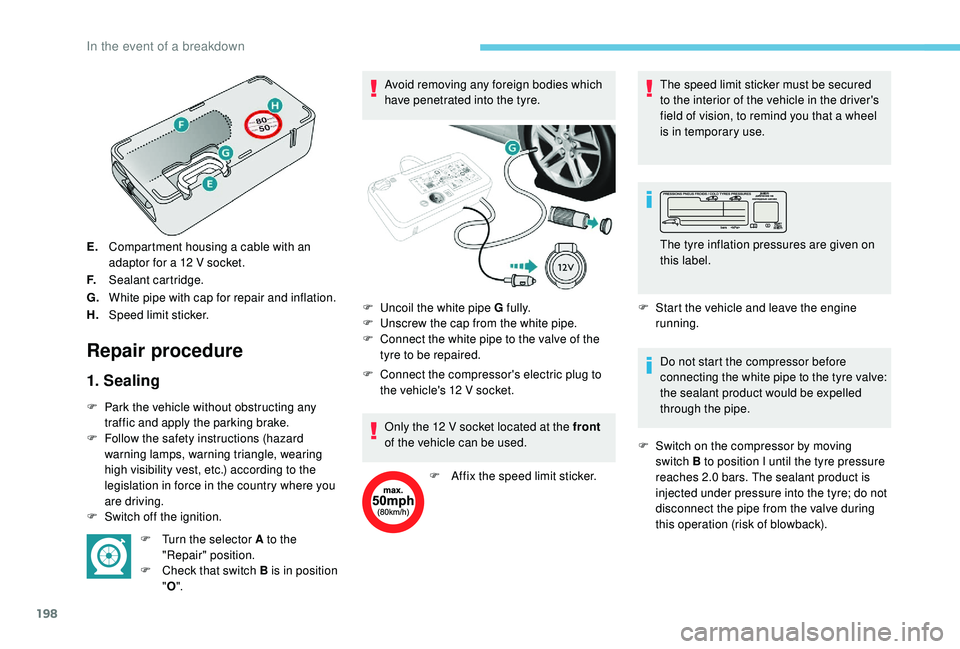
198
E.Compartment housing a cable with an
adaptor for a 12
V socket.
F. Sealant cartridge.
G. White pipe with cap for repair and inflation.
H. Speed limit sticker.
Repair procedure
1. Sealing
F Park the vehicle without obstructing any
traffic and apply the parking brake.
F
F
ollow the safety instructions (hazard
warning lamps, warning triangle, wearing
high visibility vest, etc.) according to the
legislation in force in the country where you
are driving.
F
S
witch off the ignition. F
T
urn the selector A to the
"Repair" position.
F
C
heck that switch B is in position
" O ". Avoid removing any foreign bodies which
have penetrated into the tyre.
F
C
onnect the compressor's electric plug to
the vehicle's 12 V socket.
Only the 12 V socket located at the front
of the vehicle can be used.
F
A
ffix the speed limit sticker.The speed limit sticker must be secured
to the interior of the vehicle in the driver's
field of vision, to remind you that a wheel
is in temporary use.
F
S
tart the vehicle and leave the engine
running.
Do not start the compressor before
connecting the white pipe to the tyre valve:
the sealant product would be expelled
through the pipe.
F
S
witch on the compressor by moving
switch B to position I until the tyre pressure
reaches 2.0
bars. The sealant product is
injected under pressure into the tyre; do not
disconnect the pipe from the valve during
this operation (risk of blowback).
F
U
ncoil the white pipe G fully.
F
U
nscrew the cap from the white pipe.
F
C
onnect the white pipe to the valve of the
tyre to be repaired. The tyre inflation pressures are given on
this label.
In the event of a breakdown
Page 201 of 324
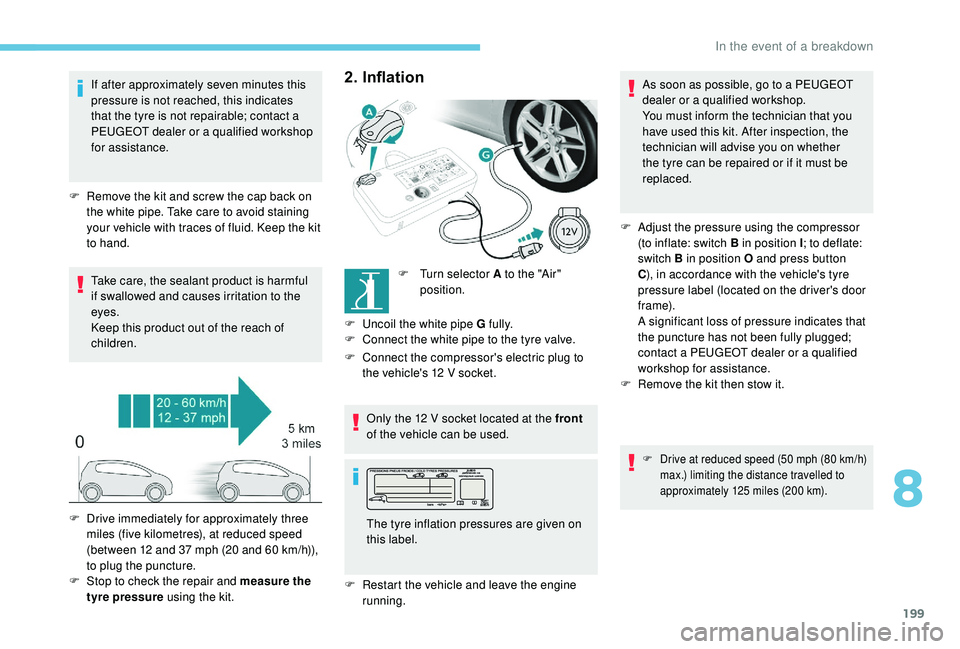
199
If after approximately seven minutes this
pressure is not reached, this indicates
that the tyre is not repairable; contact a
PEUGEOT dealer or a qualified workshop
for assistance.
F
R
emove the kit and screw the cap back on
the white pipe. Take care to avoid staining
your vehicle with traces of fluid. Keep the kit
to hand.
Take care, the sealant product is harmful
if swallowed and causes irritation to the
eyes.
Keep this product out of the reach of
children.2. Inflation
F Turn selector A to the "Air" position.
F
U
ncoil the white pipe G fully.
F
C
onnect the white pipe to the tyre valve.
F
C
onnect the compressor's electric plug to
the vehicle's 12
V socket.
Only the 12
V socket located at the front
of the vehicle can be used.
F
R
estart the vehicle and leave the engine
running.
F
D
rive immediately for approximately three
miles (five kilometres), at reduced speed
(between 12 and 37
mph (20 and 60
km/h)),
to plug the puncture.
F
S
top to check the repair and measure the
tyre pressure using the kit. The tyre inflation pressures are given on
this label. As soon as possible, go to a PEUGEOT
dealer or a qualified workshop.
You must inform the technician that you
have used this kit. After inspection, the
technician will advise you on whether
the tyre can be repaired or if it must be
replaced.
F
A
djust the pressure using the compressor
(to inflate: switch B in position I ; to deflate:
switch B in position O and press button
C ), in accordance with the vehicle's tyre
pressure label (located on the driver's door
f r a m e).
A significant loss of pressure indicates that
the puncture has not been fully plugged;
contact a PEUGEOT dealer or a qualified
workshop for assistance.
F
R
emove the kit then stow it.
F Drive at reduced speed (50 mph (80 km/h)
max.) limiting the distance travelled to
approximately 125
miles (200 km).
8
In the event of a breakdown
Page 202 of 324

200
Removing the pipe and
cartridge
Be careful of fluid discharge.
The expiry date of the fluid is indicated on
the cartridge.
The sealant cartridge is designed for
single use; it must be replaced even if only
partly used.
After use, do not discard the cartridge into
the environment, take it to an authorised
waste disposal site or a PEUGEOT dealer.
Do not forget to obtain a new sealant
cartridge, available from PEUGEOT
dealers or from a qualified workshop.
Checking/adjusting tyre
pressures
You can also use the compressor,
without injecting sealant, to check and, if
necessary, adjust the tyre pressures.F
T
urn selector A to the "Air"
position.
F
U
ncoil the white pipe G fully.
F
C
onnect the pipe to the tyre
valve.
F
C
onnect the compressor's electric plug to
the vehicle's 12 V socket.
Only the 12 V socket located at the front
of the vehicle can be used.
F
S
tart the vehicle and leave the engine
running.
F
T
urn the pipe assembly 2 to the left until it
comes into contact with the unit.
F
D
isconnect the connector 1 from the
cartridge by turning it a quarter turn anti-
clockwise.
F
P
ull the pipe assembly 2 out slightly, then
disconnect the connector 3 from the air
intake pipe by turning it a quarter turn anti-
clockwise. F
R
emove the pipe assembly 2
.
F
K
eep the compressor vertical.
F
U
nscrew the cartridge 4 from the bottom.
To fit the new cartridge and new pipe, carry out
these operations in reverse order.
The tyre inflation pressures are given on
this label.
In the event of a breakdown
Page 203 of 324
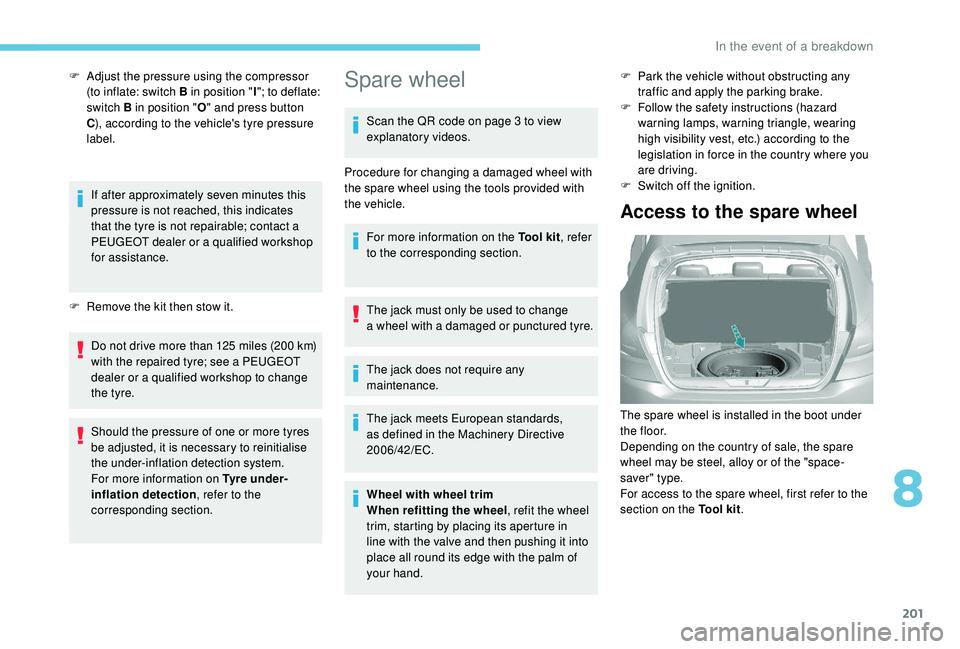
201
F Adjust the pressure using the compressor (to inflate: switch B in position " I"; to deflate:
switch B in position " O" and press button
C ), according to the vehicle's tyre pressure
label.
If after approximately seven minutes this
pressure is not reached, this indicates
that the tyre is not repairable; contact a
PEUGEOT dealer or a qualified workshop
for assistance.
F
R
emove the kit then stow it.
Do not drive more than 125
miles (200 km)
with the repaired tyre; see a PEUGEOT
dealer or a qualified workshop to change
the tyre.
Should the pressure of one or more tyres
be adjusted, it is necessary to reinitialise
the under-inflation detection system.
For more information on Tyre under-
inflation detection , refer to the
corresponding section.Spare wheel
Scan the QR code on page 3 to view
explanatory videos.
Procedure for changing a damaged wheel with
the spare wheel using the tools provided with
the vehicle. For more information on the Tool kit , refer
to the corresponding section.
The jack must only be used to change
a wheel with a damaged or punctured tyre.
The jack does not require any
maintenance.
The jack meets European standards,
as defined in the Machinery Directive
2006/42/EC.
Wheel with wheel trim
When refitting the wheel , refit the wheel
trim, starting by placing its aperture in
line with the valve and then pushing it into
place all round its edge with the palm of
your hand. F
P
ark the vehicle without obstructing any
traffic and apply the parking brake.
F F ollow the safety instructions (hazard
warning lamps, warning triangle, wearing
high visibility vest, etc.) according to the
legislation in force in the country where you
are driving.
F
S
witch off the ignition.
Access to the spare wheel
The spare wheel is installed in the boot under
t h e f l o o r.
Depending on the country of sale, the spare
wheel may be steel, alloy or of the "space-
saver" type.
For access to the spare wheel, first refer to the
section on the Tool kit.
8
In the event of a breakdown
Page 207 of 324
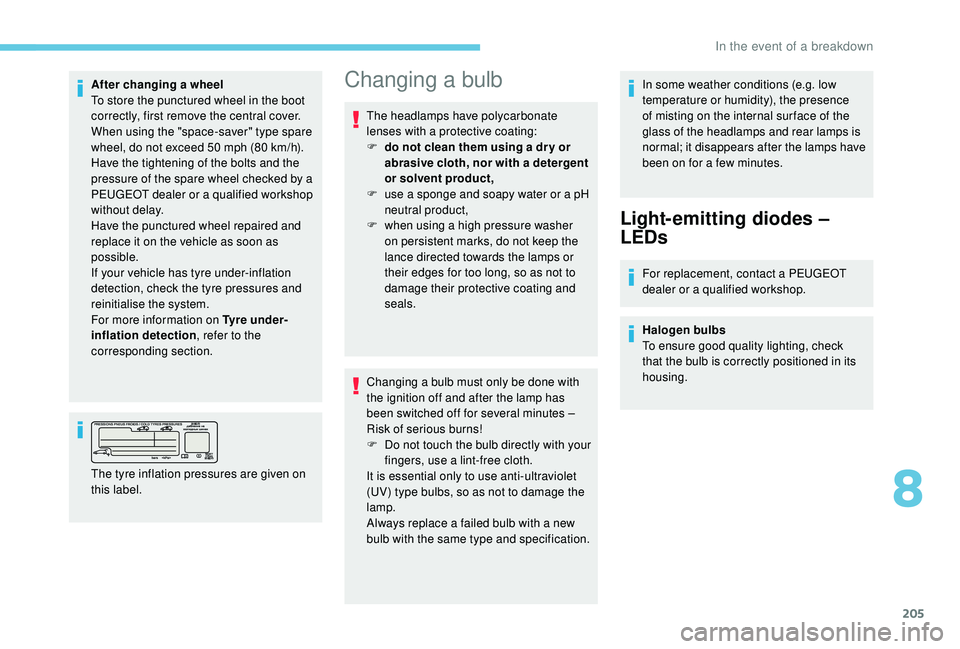
205
After changing a wheel
To store the punctured wheel in the boot
correctly, first remove the central cover.
When using the "space-saver" type spare
wheel, do not exceed 50 mph (80 km/h).
Have the tightening of the bolts and the
pressure of the spare wheel checked by a
PEUGEOT dealer or a qualified workshop
without delay.
Have the punctured wheel repaired and
replace it on the vehicle as soon as
possible.
If your vehicle has tyre under-inflation
detection, check the tyre pressures and
reinitialise the system.
For more information on Tyre under-
inflation detection , refer to the
corresponding section.
The tyre inflation pressures are given on
this label.Changing a bulb
The headlamps have polycarbonate
lenses with a protective coating:
F
d
o not clean them using a dr y or
abrasive cloth, nor with a detergent
or solvent product,
F
u
se a sponge and soapy water or a pH
neutral product,
F
w
hen using a high pressure washer
on persistent marks, do not keep the
lance directed towards the lamps or
their edges for too long, so as not to
damage their protective coating and
seals.
Changing a bulb must only be done with
the ignition off and after the lamp has
been switched off for several minutes –
Risk of serious burns!
F
D
o not touch the bulb directly with your
fingers, use a lint-free cloth.
It is essential only to use anti-ultraviolet
(UV) type bulbs, so as not to damage the
lamp.
Always replace a failed bulb with a new
bulb with the same type and specification. In some weather conditions (e.g. low
temperature or humidity), the presence
of misting on the internal sur face of the
glass of the headlamps and rear lamps is
normal; it disappears after the lamps have
been on for a few minutes.
Light-emitting diodes –
LEDs
For replacement, contact a PEUGEOT
dealer or a qualified workshop.
Halogen bulbs
To ensure good quality lighting, check
that the bulb is correctly positioned in its
housing.
8
In the event of a breakdown
Page 235 of 324
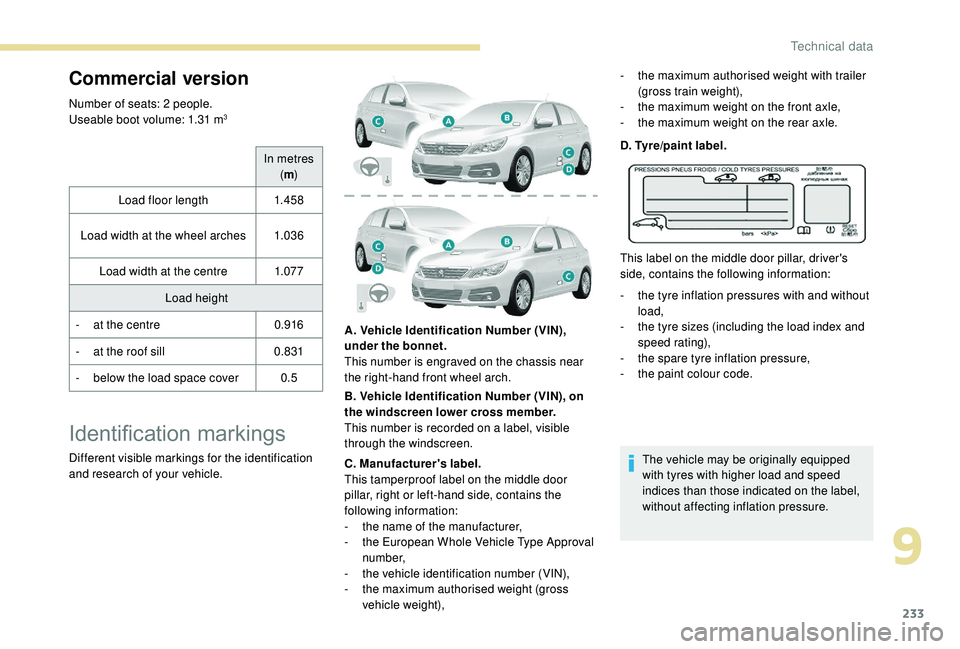
233
Commercial version
Number of seats: 2 people.
Useable boot volume: 1.31 m3
In metres (m )
Load floor length 1.4 5 8
Load width at the wheel arches 1.03 6
Load width at the centre 1.07 7
Load height
-
a
t the centre 0.916
-
a
t the roof sill 0.831
-
b
elow the load space cover 0.5
Identification markings
Different visible markings for the identification
and research of your vehicle. A. Vehicle Identification Number (VIN),
under the bonnet.
This number is engraved on the chassis near
the right-hand front wheel arch.
B. Vehicle Identification Number (VIN), on
the windscreen lower cross member.
This number is recorded on a label, visible
through the windscreen.
C. Manufacturer's label.
This tamperproof label on the middle door
pillar, right or left-hand side, contains the
following information:
-
t
he name of the manufacturer,
-
t
he European Whole Vehicle Type Approval
number,
-
t
he vehicle identification number (VIN),
-
t
he maximum authorised weight (gross
vehicle weight), D. Tyre/paint label.
This label on the middle door pillar, driver's
side, contains the following information:
-
t
he tyre inflation pressures with and without
load,
-
t
he tyre sizes (including the load index and
speed rating),
-
t
he spare tyre inflation pressure,
-
t
he paint colour code.
The vehicle may be originally equipped
with tyres with higher load and speed
indices than those indicated on the label,
without affecting inflation pressure.
-
t
he maximum authorised weight with trailer
(gross train weight),
-
t
he maximum weight on the front axle,
-
t
he maximum weight on the rear axle.
9
Technical data
Page 316 of 324

238
Player, Apple® .......................................9 , 10, 24
Player, MP3 CD ............................... ................23
Player, USB
............................................. 7, 9, 23
Port, USB
.................................... 58, 60, 7, 9, 23
Pre-heater, Diesel
........................................... 17
Pressures, tyres
.................... 188, 197, 205, 233
Pre-tensioning seat belts
................................ 91
Priming pump
................................................ 2
20
Priming the fuel system
................................ 220
Profiles
...................................................... 16, 30
Protecting children
...................
93, 95 -96, 99, 101, 102, 104, 105, 107
Puncture
........................................ 19 4, 19 6, 20 0
RRadio ......................................... 4-5, 6, 9, 21, 24
Radio, digital (Digital Audio Broadcasting – DAB)
............................6, 8, 22
Range, AdBlue
.......................................... 25 -26
RDS
................
........................................ 7, 2 1 - 2 2
Rear screen, demisting
..............................70 -71
Recharging the battery
..........................216,217
Recirculation, air
....................................... 67- 6 9
Reduction of electrical load
..........................181
Regeneration of the particle filter
.................187
Reinitialisation of the under- inflation detection system
...........................167
Reinitialising the remote control
............... 45
-46
Reminder, key in ignition
...............................11
2
Remote control
.......................................... 39-44
Removing a wheel
........................202, 204,205
Removing the mat
........................................... 59
Replacing bulbs
..................... 20
5,206, 209,210
Replacing fuses
..................................... 211,213
Replacing the air filter
............................ 18
6,187
Replacing the oil filter
................................... 18
7
Replacing the passenger compartment filter ...............................18 6,187
Reservoir, headlamp wash
........................... 18
6
Reservoir, screenwash
.................................18 6
Resetting the service indicator
.................23 -24
Resetting the trip recorder
.........................27-2 8
Reversing camera
...............................
..........15 8
Reversing lamp
...................................... 209,210
Roof bars
....................................................... 182
Running out of fuel (Diesel)
..........................220
SSafety, children ...3, 95 -96, 99, 101, 104, 105, 107Saturation of the particle filter (Diesel) ......... 18 7
SCR (Selective Catalytic Reduction) ............188
Screen, cold climate
...............................17
3 ,174
Screen, instrument panel
..........................28-29
Screen, monochrome
...............................30-32
Screen, multifunction (with audio system)
...................................... 30 -32, 4
Screen menu map
........................................... 12
Screenwash
.................................................... 81
Screenwash, rear
............................................ 81
Seat, rear bench
....................................... 56-58
Seat belts
..................................... 11, 9 0 - 91, 10 0
Seats, electric
........................................... 52-53
Seats, front
...............................
..................51- 5 3
Seats, heated
.................................................. 53
Seats, rear
................................................. 56-58
Selector, gear
......................................... 12 2,126
Serial number, vehicle
..................................233
Service indicator
............................................. 23
Servicing
..................................................... 6
, 23
Settings, equipment
............................30-34, 36
Settings, system
........................................ 16, 30
Sidelamps
............................... 7
6, 206, 208,210
Side repeater
................................................ 208Ski flap
..............................
..............................
61
Snow chains
..........................................
1 6 7, 17 3
Socket, 12 V accessory .....................
58, 60, 62
Socket, 220 V ..................................................
60
Socket, 230 V
...............................
...................
58
Socket, auxiliary
...................................... 8
, 9, 23
Socket, Jack
......................................
58, 8, 9, 23
Sockets, audio
................................................ 60
Spe
ed limiter
..................................
13
0, 132,13 5
Speed limit recognition
.......................... 13
1,132
Spotlamps, door mirror
...................................
79
Starting a Diesel engine
............................... 17
2
Starting the engine
................................. 11
0 ,111
Starting the vehicle
..................
1
2 -14 , 1 8 -1 9 , 112 ,113 , 11 9 ,12 6
Starting using another battery ..............
113 , 2 15
Station, radio ............................... ......4, 6, 21-22
Stay, bonnet
..................................................183
Steering mounted controls, audio
........ 2
-3, 3, 3
Stop & Start .................................
20, 30, 66, 70, 128, 130, 171, 183, 186, 215, 217
Stopping the vehicle ................
12 -14 , 1 8 -1 9 , 112 ,113 , 11 9 ,12 6
Storage
...................................................... 58-62
Storage wells
.................................................. 62
Storing driving positions
................................. 53
S
towing rings
.................................................. 62
Sunshine sensor
............................................. 65
Switching off the engine
.........................11 0 ,111
Synchronising the remote control
.............45-46
Alphabetical index